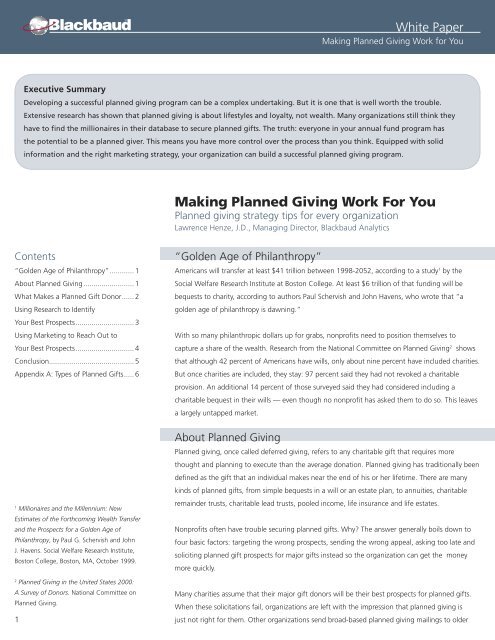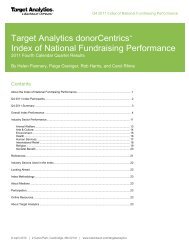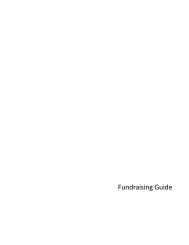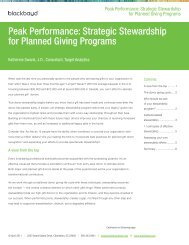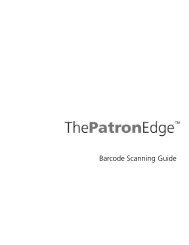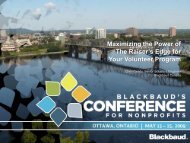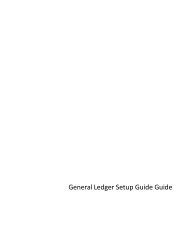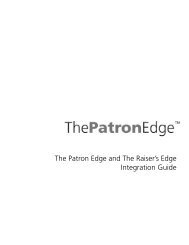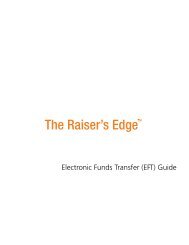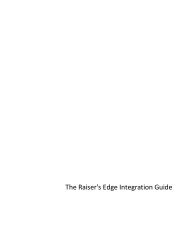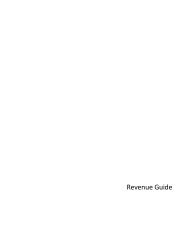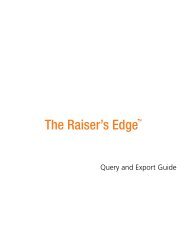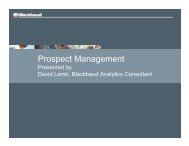White Paper Making Planned Giving Work for You - Blackbaud, Inc.
White Paper Making Planned Giving Work for You - Blackbaud, Inc.
White Paper Making Planned Giving Work for You - Blackbaud, Inc.
You also want an ePaper? Increase the reach of your titles
YUMPU automatically turns print PDFs into web optimized ePapers that Google loves.
<strong>White</strong> <strong>Paper</strong><strong>Making</strong> <strong>Planned</strong> <strong>Giving</strong> <strong>Work</strong> <strong>for</strong> <strong>You</strong>Executive SummaryDeveloping a successful planned giving program can be a complex undertaking. But it is one that is well worth the trouble.Extensive research has shown that planned giving is about lifestyles and loyalty, not wealth. Many organizations still think theyhave to find the millionaires in their database to secure planned gifts. The truth: everyone in your annual fund program hasthe potential to be a planned giver. This means you have more control over the process than you think. Equipped with solidin<strong>for</strong>mation and the right marketing strategy, your organization can build a successful planned giving program.<strong>Making</strong> <strong>Planned</strong> <strong>Giving</strong> <strong>Work</strong> For <strong>You</strong><strong>Planned</strong> giving strategy tips <strong>for</strong> every organizationLawrence Henze, J.D., Managing Director, <strong>Blackbaud</strong> AnalyticsContents“Golden Age of Philanthropy” ............ 1About <strong>Planned</strong> <strong>Giving</strong> ......................... 1What Makes a <strong>Planned</strong> Gift Donor ...... 2Using Research to Identify<strong>You</strong>r Best Prospects ............................. 3Using Marketing to Reach Out to<strong>You</strong>r Best Prospects ............................. 4Conclusion .......................................... 5Appendix A: Types of <strong>Planned</strong> Gifts ..... 61Millionaires and the Millennium: NewEstimates of the Forthcoming Wealth Transferand the Prospects <strong>for</strong> a Golden Age ofPhilanthropy, by Paul G. Schervish and JohnJ. Havens. Social Welfare Research Institute,Boston College, Boston, MA, October 1999.“Golden Age of Philanthropy”Americans will transfer at least $41 trillion between 1998-2052, according to a study 1 by theSocial Welfare Research Institute at Boston College. At least $6 trillion of that funding will bebequests to charity, according to authors Paul Schervish and John Havens, who wrote that “agolden age of philanthropy is dawning.”With so many philanthropic dollars up <strong>for</strong> grabs, nonprofits need to position themselves tocapture a share of the wealth. Research from the National Committee on <strong>Planned</strong> <strong>Giving</strong> 2 showsthat although 42 percent of Americans have wills, only about nine percent have included charities.But once charities are included, they stay: 97 percent said they had not revoked a charitableprovision. An additional 14 percent of those surveyed said they had considered including acharitable bequest in their wills — even though no nonprofit has asked them to do so. This leavesa largely untapped market.About <strong>Planned</strong> <strong>Giving</strong><strong>Planned</strong> giving, once called deferred giving, refers to any charitable gift that requires morethought and planning to execute than the average donation. <strong>Planned</strong> giving has traditionally beendefined as the gift that an individual makes near the end of his or her lifetime. There are manykinds of planned gifts, from simple bequests in a will or an estate plan, to annuities, charitableremainder trusts, charitable lead trusts, pooled income, life insurance and life estates.Nonprofits often have trouble securing planned gifts. Why? The answer generally boils down tofour basic factors: targeting the wrong prospects, sending the wrong appeal, asking too late andsoliciting planned gift prospects <strong>for</strong> major gifts instead so the organization can get the moneymore quickly.2<strong>Planned</strong> <strong>Giving</strong> in the United States 2000:A Survey of Donors. National Committee on<strong>Planned</strong> <strong>Giving</strong>.1Many charities assume that their major gift donors will be their best prospects <strong>for</strong> planned gifts.When these solicitations fail, organizations are left with the impression that planned giving isjust not right <strong>for</strong> them. Other organizations send broad-based planned giving mailings to older
Faced with poor responses to theirplanned giving solicitations, manyorganizations have focused onsoliciting annual funds rather thanexpending resources to seek outfuture dollars. If you are doing this,however, you could be missing amajor opportunity to strengthenthe long-term viabilityof your charity.donors, telling them about a multitude of planned giving vehicles and asking them to contact theorganization <strong>for</strong> more in<strong>for</strong>mation. In my experience, returns on such requests <strong>for</strong> in<strong>for</strong>mationoften average less than one percent. Moreover, little – if any – personal follow up is done with theprospects who do not respond.The historical lack of meaningful research on planned giving has done little to help nonprofits rethinktheir strategies. It is often difficult to get reliable, accurate in<strong>for</strong>mation on planned giving donors, asbetween 70-90 percent of all bequests are unknown to the charity until after the donor’s death. Addto this the fact that, <strong>for</strong> many groups, their small cadre of planned gift donors are trustees, boardmembers and others with unusually close relationships to the charity, and much of what researchersthought they knew about planned giving prospects has proved to be wrong.Faced with poor responses to their planned giving solicitations, many organizations have focusedon soliciting annual funds rather than expending resources to seek out future dollars. If youare doing this, however, you could be missing a major opportunity to strengthen the long-termviability of your charity.What Makes a <strong>Planned</strong> Gift Donor?The most recent National Committee on <strong>Planned</strong> <strong>Giving</strong> survey offers some insight into whypeople make charitable bequests:• 97 percent say they care about the charity• 82 percent want to do something special• 35 percent use planned giving as an income or estate tax planning strategy• 21 percent say they know someone at the organizationResearch, including the National Committee on <strong>Planned</strong> <strong>Giving</strong> survey, has also provided a betterunderstanding in recent years of who makes the best planned giving prospects. The answer:annual gift donors. Contrary to conventional wisdom, most major gift donors have made theirbig donation to the organization — and, in my experience, are unlikely to make a second largegift. As a result, it is important <strong>for</strong> charities to focus attention on building long-term relationshipswith those donors who are counted on <strong>for</strong> donations year after year.Not every annual gift donor is alike; and different types of people are likely to gravitate to differentplanned giving vehicles. The good news is that there are some income and lifestyle factors thatcan help you to distinguish your best bequest prospects from your charitable gift annuity orcharitable remainder trust prospects:• Older retirees on fixed incomes who still give to the charity, although the size of their annualdonation may have plateaued or gone down, are likely to make a charitable bequest as theywant to make a final gift to the organization they care about the most.2• <strong>You</strong>nger married couples in their <strong>for</strong>ties and fifties are also good charitable bequestprospects. They typically still have children at home, tend to have moderate to uppermoderateincomes, and are active consumers who use credit and get credit much moreaggressively than older retirees.
• Single females over age 65, many of whom have outlived spouses, are excellent prospects <strong>for</strong>charitable gift annuities. They tend to be living on fixed incomes and are worried about theirfuture income stream. Annuities appeal to them because they guarantee an income stream<strong>for</strong> the rest of their lives.• Wealthier people between their mid-50s and age 70 are good charitable remainder trustprospects. They are typically fiscally aggressive, and their credit histories and lifestyles indicatethat they are upscale and ostentatious. Some may in fact have made a major gift prior toestablishing a trust.Armed with these donor profiles, there are steps you can take to identify and target the plannedgiving prospects in your database.Using Research to Identify <strong>You</strong>r Best ProspectsAccording to research on fundraising and philanthropy, each person in your database has anultimate gift potential <strong>for</strong> your organization. For many, the ultimate gift potential may be $0.Perhaps they are not charitably inclined — or an alumnus only gives to his graduate school, or a<strong>for</strong>mer patient paid a large bill and does not think of your hospital as a charitable entity. Otherpeople in your database, however, may be loyal donors, giving pretty much the same amount yearafter year.According to the concept of ultimate giving potential, there is a third category of people in yourdatabase: those who are likely to make a large donation. These are the people you should analyzemost closely and with whom your organization should build relationships. They include three typesof donors:As you look at your donors,their lifestyles and their givinghistories in order to identify yourbest planned giving prospects,it is important to avoid usingmisleading data.• those who will make a major gift (however defined by the organization);• those who will make some <strong>for</strong>m of planned gift; and• those who will do both.My experience shows that this last category is typically comprised of the 15 percent of prospectsat the top end of your donor list who know your charity the best.As you look at your donors, their lifestyles and their giving histories in order to identify your bestplanned giving prospects, it is important to avoid using misleading data. Most generic modelsused to identify individuals to approach, <strong>for</strong> example, will steer you toward people who havereached a certain age and income level. While you might find some good major gift prospects, thisdoes nothing to identify who is likely to make a planned gift. Similarly, an intuitive model will lookat those people in your database who have already made a planned gift — mostly trustees witha close affinity to your organization and other top donors — and assume that all your plannedgiving prospects will share similar characteristics. Yet the research on planned giving makes clearthey do not.3The good news is that individuals who make planned gifts, whether to a university, a hospital,a human rights group or an art museum, tend to look very similar from organization to
organization. This is where predictive modeling can help. Our statistical models incorporate overa decade’s worth of planned giving behavior around the country. This means that we can applyhistorical giving patterns to analyze your database and create profiles of your annual donors bytype of planned gift.Although it is important to understand who your best bequest prospects are, or your best “trust”prospects, this knowledge does not instantly translate into fundraising success. <strong>You</strong> still need tosolicit planned gifts <strong>for</strong> your organization. Here again, your profiles can help you to devise the bestmarketing approach <strong>for</strong> these different potential donors.Lawrence Henze, managing directorof <strong>Blackbaud</strong> Analytics, has extensiveexperience in fundraising, market researchand the application of predictive modelingservices to the nonprofit marketplace.The founder of Core Data Services, which<strong>Blackbaud</strong> acquired in 2001, he has alsoserved as vice president of predictivemodeling services at USA Group Noel Levitzand president of The Philanthropic Division ofEconometrics, <strong>Inc</strong>.Mr. Henze has 15 years of experience indevelopment, raising more than $125million, primarily <strong>for</strong> higher educationinstitutions. During his career, he haspersonally reviewed the giving histories ofmore than 30,000 planned givers across thecountry. He holds a BA in political sciencefrom Carroll College in Wisconsin, and anMA in public policy and administration and alaw degree from the University of Wisconsinat Madison.Using Marketing to Reach Out to <strong>You</strong>r Best ProspectsUnderstanding how to ask <strong>for</strong> a donation is always critical, and research on planned giving offersuseful guidance to steer the right message to the right person. Here are some tips to help you getstarted:1. Keep your message simpleWhen soliciting <strong>for</strong> a planned gift, simplicity is key. The most successful solicitations are clear,concise and focus on only one type of planned gift at a time. Because we know that bequestprospects are different from annuities prospects, <strong>for</strong> example, there is no reason to send anyonein<strong>for</strong>mation about both giving vehicles. And do not talk about a CRAT 3 or a CRUT 4 — eliminatethe acronyms, technical language and insider jargon in favor of plain English.2. Make anniversary date solicitationsThe best time to ask someone <strong>for</strong> a donation is when he or she is most likely to make one. <strong>You</strong>should analyze your database to learn which donors faithfully give in a particular month orquarter. If you know when someone gives each year, then you can gear your solicitation to thattime of year (and eliminate mailings they will never respond to and telephone calls that mightannoy them). This will save you money even as you build a more meaningful relationship withyour donors. In addition, research shows that anniversary date donors tend to be good plannedgiving prospects.3. Adopt a segmented solicitation strategyNo solicitation strategy will be effective if you do not ask the right way. Segmenting your databasebased on who responds to what type of solicitation (e.g. direct mail as opposed to telemarketing)will improve your response rates and save your organization money. Understanding who gives— and what solicitation different individuals will respond to — also offers you another way totarget potential donors. Research shows, <strong>for</strong> example, that people who respond to direct mailsolicitations have historically been more likely than telemarketing-responsive people to be goodplanned giving prospects.3Charitable Remainder Annuity Trust4Charitable Remainder Unitrust44. Cultivate relationships with annual donorsOnce you understand that your best planned giving prospects will come from the ranks of yourannual givers, the next step is to build an ongoing relationship with these individuals. Ideally,officers and other top representatives of your nonprofit should reach out to consistent givers oncethey reach age 40 to cement their relationships with the organization. While the personal touch is
time consuming, the long-term payoff can be substantial.5. Encourage your annual fund staff to collaborate with your planned giving teamSuccessfully securing planned gifts is all about building relationships with donors. Make surethe staff managing your annual fund understands both the importance of promoting long-termrelationships and how their work can help result in larger gifts to the organization over time. Ifa spot opens up on either team, make sure you place emphasis on hiring a good communicator.about <strong>Blackbaud</strong><strong>Blackbaud</strong> is the leading global providerof software and related services designedspecifically <strong>for</strong> nonprofit organizations. Morethan 12,500 organizations use <strong>Blackbaud</strong>products and consulting services <strong>for</strong> fundraising,financial management, business intelligenceand school administration. <strong>Blackbaud</strong>’sTechnical expertise is abundantly available from financial planners and attorneys.ConclusionNonprofits are discovering that the right planned giving program can bring in significant donationsand provide a future income stream <strong>for</strong> their organizations. A successful program depends onsolid research, savvy marketing and — most importantly — understanding the characteristics ofa typical planned gift donor. Once your planned giving strategy is in place, your nonprofit will bepoised to capture a share of the estimated $6 trillion in philanthropic donations up <strong>for</strong> grabs overthe next half-century.solutions include The Raiser’s Edge ® , TheFinancial Edge, The Education Edge,The In<strong>for</strong>mation Edge, WealthPoint andProspectPoint, as well as a wide range ofconsulting and educational services. Founded in1981, <strong>Blackbaud</strong> is headquartered in Charleston,South Carolina, and has operations in Toronto,Ontario; Glasgow, Scotland; and Sydney,Australia.For more in<strong>for</strong>mation about <strong>Blackbaud</strong>solutions, contact a <strong>Blackbaud</strong> accountrepresentative. In the United States and Canadacall toll-free 800-443-9441. In Europe call +44(0) 141 575 0000 or visit us on the web atwww.blackbaud.com© October 2004, <strong>Blackbaud</strong> <strong>Inc</strong>.This white paper is <strong>for</strong> in<strong>for</strong>mational purposes only.<strong>Blackbaud</strong> makes no warranties, expressed or implied,in this summary. The in<strong>for</strong>mation contained in thisdocument represents the current view of <strong>Blackbaud</strong> <strong>Inc</strong>.on the items discussed as of the date of this publication.5
Appendix: Types of <strong>Planned</strong> GiftsDonors are making a number of different types of planned gifts. Here are some of the mostpopular ones.• Bequest — A provision in a will or estate plan that allocates all or part of the individual’sestate to a designated charity.• Charitable Remainder Trust — An irrevocable trust that pays a specified annual amountto one or more people <strong>for</strong> a fixed period of years (often the life of the individual). At the endof the term of the trust, the remaining trust assets are distributed to the charity. A charitableremainder annuity trust provides a fixed payment; a charitable remainder unitrust pays out afixed percentage of the trust value each year.• Charitable Lead Trust — Similar to a charitable remainder trust, but the principal reverts tothe donor or his or her designated heirs at the end of the trust term. If the principal revertsto the donor, he or she gets a charitable income tax deduction; if an heir, that person gets acharitable gift tax deduction.• Charitable Gift Annuity — An irrevocable transfer of property (e.g. securities) in exchange<strong>for</strong> a contract to pay the donor an annuity <strong>for</strong> life. Because the value of the property exceedsthe value of the annuity, it is partially a gift to the institution.• Life Insurance — An arrangement in which a donor gives a life insurance policy to thecharity. The cash value of that gift is tax deductible, as are any future premiums the donormay opt to pay on that policy. Note that only life insurance policies that are paid in full qualifyas planned gifts.• Life Estate — An arrangement in which a donor gives her home to the nonprofit whileretaining the right to live there <strong>for</strong> the remainder of her life. The donor receives an immediateincome tax deduction. The charity may sell the property upon the donor’s death.• Pooled <strong>Inc</strong>ome Fund — An arrangement, similar to a mutual fund, in which a donorcontributes to a fund and receives a share of the proceeds based on the percentage of hiscontribution. Donors pay no capital gains on the transfer of appreciated property. When thedonor dies, his shares transfer to the charity.6


